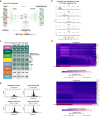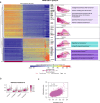Time-series single-cell transcriptomic profiling of luteal-phase endometrium uncovers dynamic characteristics and its dysregulation in recurrent implantation failures
- PMID: 39747825
- PMCID: PMC11695634
- DOI: 10.1038/s41467-024-55419-z
Time-series single-cell transcriptomic profiling of luteal-phase endometrium uncovers dynamic characteristics and its dysregulation in recurrent implantation failures
Abstract
Understanding human endometrial dynamics in the establishment of endometrial receptivity remains a challenge, which limits early diagnosis and treatment of endometrial-factor infertility. Here, we decode the endometrial dynamics of fertile women across the window of implantation and characterize the endometrial deficiency in women with recurrent implantation failure. A computational model capable of both temporal prediction and pattern discovery is used to analyze single-cell transcriptomic data from over 220,000 endometrial cells. The time-series atlas highlights a two-stage stromal decidualization process and a gradual transitional process of the luminal epithelial cells across the window of implantation. In addition, a time-varying gene set regulating epithelium receptivity is identified, based on which the recurrent implantation failure endometria are stratified into two classes of deficiencies. Further investigation uncovers a hyper-inflammatory microenvironment for the dysfunctional endometrial epithelial cells of recurrent implantation failure. The holistic characterization of the physiological and pathophysiological window of implantation and a computational tool trained on this temporal atlas provide a platform for future therapeutic developments.
© 2024. The Author(s).
Conflict of interest statement
Competing interests: X.X. was an employee of Geneplus-Shenzhen. All the other authors declare no competing interests.
Figures






References
-
- Noyes, R. W., Hertig, A. T. & Rock, J. Dating the endometrial biopsy. Am. J. Obstet. Gynecol.122, 262–263 (1975). - PubMed
-
- Wilcox, A. J., Baird, D. D. & Weinberg, C. R. Time of implantation of the conceptus and loss of pregnancy. N. Engl. J. Med.340, 1796–1799 (1999). - PubMed
-
- Croxatto, H. B. et al. Studies on the duration of egg transport by the human oviduct. II. Ovum location at various intervals following luteinizing hormone peak. Am. J. Obstet. Gynecol.132, 629–634 (1978). - PubMed
-
- Achache, H. & Revel, A. Endometrial receptivity markers, the journey to successful embryo implantation. Hum. Reprod. Update12, 731–746 (2006). - PubMed
Publication types
MeSH terms
Associated data
- Actions
- Actions
- Actions
- Actions
- Actions
- Actions
- Actions
- Actions
LinkOut - more resources
Full Text Sources

